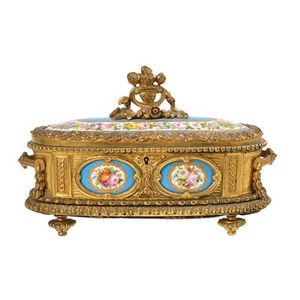Dragon Carved Rosewood Throne Chair with Footstool
You must be a subscriber, and be logged in to view price and dealer details.
Subscribe Now to view actual auction price for this item
When you subscribe, you have the option of setting the currency in which to display prices to $Au, $US, $NZ or Stg.
- Manner of .... / Style of ..... - A cataloguing term where the item, in the opinion of the cataloguer is a work in the style of the artist, craftsman or designer, possibly of a later period.
- Ming Dynasty - The Ming Dynasty was a ruling dynasty of China from 1368 to 1644. It succeeded the Yuan Dynasty and preceded the Qing Dynasty. The Ming Dynasty was established by Zhu Yuanzhang, a former Buddhist monk who became a rebel leader and eventually overthrew the Mongol Yuan Dynasty. During the Ming Dynasty, China experienced a period of relative stability and prosperity. The government was centralized and bureaucratic, with the emperor at the top of the hierarchy. The Ming Dynasty is known for its cultural achievements, including the development of porcelain, the invention of movable type printing, and the construction of the Great Wall of China.
- Qing Dynasty - The Qing Dynasty was the last imperial dynasty of China, ruling from 1644 to 1912. It was established by the Manchu people, who originated from the northeastern region of China. The Qing Dynasty was preceded by the Ming Dynasty and followed by the Republic of China.
- Rosewood - A dense timber that varies in shade to very light brown to almost black. When rosewood is cut and sanded the colour of the timber will turn black, and after polishing and exposure to daylight, the surface will gradually lighten over time to light brown with black streaks.
The name comes from the odour emanating from the timber when it is planed, sanded or cut.
Rosewood was very popular for use in Victorian furniture in the second half of the 19th century, and at that time most of the rosewood was imported from Brazil. However it also grows in India and Indonesia.
It is used in the sold for chairs and table legs, but for carcase furniture such as side cabinets and bookcases, and for table tops it is always used as a veneer.
This item has been included into following indexes:
- Chinese furniture, chairs
Visually similar items

A French gilt metal cased mantel clock, mounted with Sevres-type porcelain panels and finial, the face bleu celeste glazed and with gilding, decorated with a landscape, the dial with Roman numerals, the case embellished with a floral urn pediment, foliate

A gilt metal mounted porcelain Jewell casket, hand painted porcelain insets with enriched floral and gilded ornaments on blue ground, mounted gilt metal gadrooned, scalloped rims, with a flower basket within a C-scroll and floral cartouche shaped finial on

A mahogany musical long case marquetry inlaid clock, circa 1880. 248 cm high, 51 cm wide, 34.5 cm deep

Antique American timber cased mantle clock, with 8 day striking movement, key and pendulum included, height 59 cm approx
